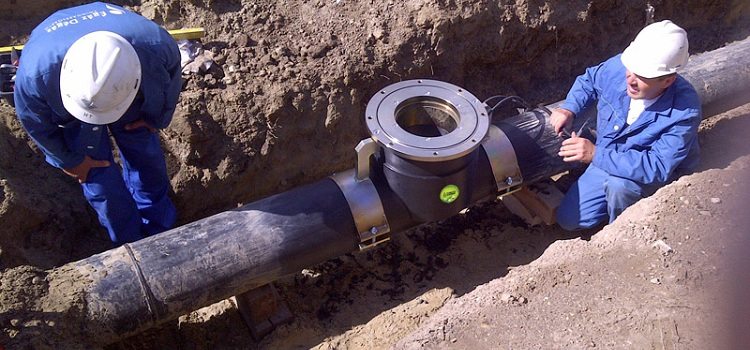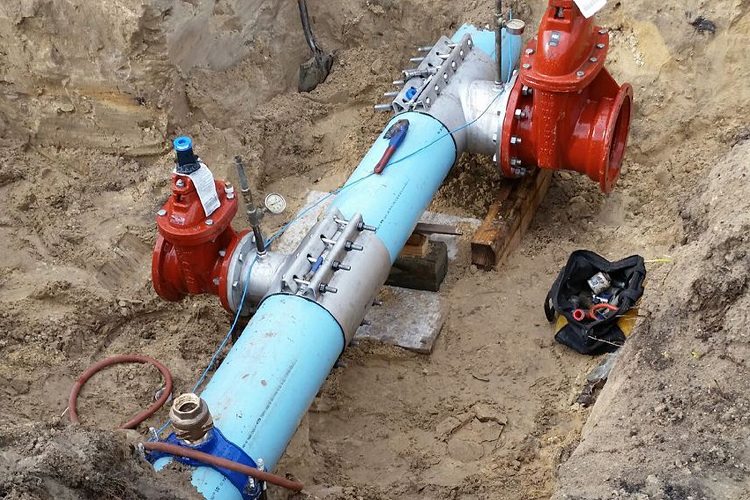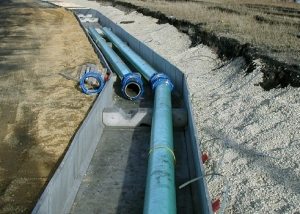Buildings in the private sector are periodically added, it is necessary to equip them and conduct communications. Inserting into a water pipe is a simple job, which can not be done in the country or your own house, but it is important to follow the rules. Connection to a common water supply system requires permission, and branching pipes on the site is an obligatory part of home improvement work. Insertion into pipes can be done with or without welding, and each type of pipeline involves its own technology.
Content
- 1 Coordination for the organization of work on the insert into the water supply system
- 2 How is the insert made?
- 3 Varieties of clamps
- 4 Features of insertion in a pipe from cast iron
- 5 Features of insertion into pipes made of synthetic materials by means of an overhead clamp
- 6 Features of tapping into a water pipe by welding
Coordination for the organization of work on the insert into the water supply system
Inserting a pipe for supplying water from a central water supply system is a necessary necessity, but independent connection to a common water supply pipe stretched along the street is impossible without receiving all documents confirming permission to insert. They independently do only branching the network on their site. There are many restrictions, for example, it is considered illegal to connect to the water supply bypassing meters. Competent insertion into the existing water supply system is available only to specialists.
Documents and a plan of the site itself, with an indication of existing communications, are provided to the relevant organizations with the confirming right to property of the site Specialists of the water utility branch will tell you how to correctly organize the insertion of the water supply into existing networks and get all the documents in your hands. Must be defined:
- insertion point for connection to the water supply network;
- pipeline diameter and general layout;
- technical parameters due to the purpose of the insert (watering, drinking water supply, general provision, etc.).
Based on the information received, a permit is issued, which must be applied to the SES for registration of documents.
The provision of water for residential buildings on the site involves not only the supply of drinking or industrial water, but also the provision of sewage (discharge of used water to a specific place). Disposal of waste products should be organized so that they do not fall into the sources of fresh water.
Attention! An inconsistent tie-in in communication entails a conflict with regulatory authorities, considerable fines, sanctions and other punishments.

For tapping into the water supply system, you must contact the appropriate service. which will issue permission and carry out work
How is the insert made?
Modern communications are built from pipes of various types. For this, metal-plastic, cast iron, steel, synthetic, polymer and composite materials are used. There are several methods for connecting to water pipes, but everything is due to the pipe material, tool and diameter of the required hole. If there are difficulties with turning off the water supply, then it is supposed to be connected by means of clamps, which facilitate insertion into the existing water supply system.
ATit is important! Without disconnecting the water supply, it is forbidden to insert into the common pipe under pressure!
There are other conditions when specialized devices or clamps are needed, for example, to get holes in a cast-iron pipe. Pipe insertion and branching of the internal water supply network are done with or without welding. The work of tapping into a polyethylene water pipe does not imply the use of welding. With any method, the basic rule cannot be ignored - the correspondence of the diameters of pipes and mills for the production of work. To get a side hole, you need a drill of the same diameter as the cross section of the connected pipeline. The “daughter” pipe should be smaller in diameter than the “mother” pipe (where the connection is made).
Welding is not possible when water is not blocked in the main communications. To the branch of the pipeline, where the water should already be drained, it is necessary to weld a tee, a threaded pipe or a sleeve on which the crane should be mounted. To make it clear, briefly the circle of tasks looks something like this:
- turn off the water;
- the pipeline is cut;
- insert a sleeve or tee;
- connect the pipe to a new branch.
Drilling equipment is connected to metal pipes through a welded pipe (not onto a clamp). It is important to make high-quality welding, without defects, and if they are identified, then the seams are re-welded. Insertion into the PND pipe is carried out by means of the adapter after turning off the water. The crown of the required format is put on a drilling tool - an adapter that is mounted on bolts.

If it is possible to shut off the water supply, then the pipe is first cut, then a tee or sleeve is inserted into the cut
There are reasons why it is impossible to block the pipeline. Most of the waterways of the old model, the valves are “stuck”, that is, rusty or clogged with calcium sediment. Not all areas were initially provided with shut-off valves. When you try to crank up the stuck thread, there is a high probability that the rusted knot will most likely fall apart, releasing water in an inappropriate place than it will completely close. Then a valve replacement is also needed.
Pressure tapping It is carried out by means of a pipeline device - a clamp or a “saddle” for inserting from 2 parts covering the pipe on both sides. The branch pipe gives a high-quality connection that will last for decades.
One of the most common methods of useless plunge-in water pipes does not involve cutting pipe parts. A small segment of the same diameter as the mother tube is needed, and at the end there are additional elements that provide overlapping of the insertion point. It should turn out, as it were, the second “wall” of the pipe pipe. The hole in the insert pipe must be of the same diameter as the inlet pipe.
The inner surface of the workpiece is lubricated with glue or sealant. They also process the surface at the hole, slightly not reaching it. Securing the pipe, use 2 clamps for tapping, tightening on both sides, but not so that not all sealant extrudes from under the pipe. Residual adhesive is removed. A similar method is used to attach ready-made flanges for tapping.
Advice! If it is not clear which method is suitable for your case, consider that the welding method is applicable for rigidly connecting threads to steel pipes where a tap or valve will be screwed. An overhead clamp is used to punch a hole in a cast-iron pipe or in communications with water under pressure.
The hole can be made in any direction - up or down, to the right or left of the pipe, depending on where it is more convenient to divert the pipe bend. Sometimes punching a hole from the right side is problematic - it is impossible to start equipment because of the main wall. Then you will have to change the configuration of the new communications section, making adjustments to the drawings. The most convenient approach to the pipe is up or on yourself.
Varieties of clamps
Insertion into the water supply system under pressure is possible only with special devices and drilling equipment. The choice of the correct clamp is very important. They are also known as saddle bends or saddles. They differ in shape, type of fastening on the pipeline, design and material of manufacture. But the locking mechanism of all insert modules is about the same.
The most convenient for inserting into a pipe based on synthetic materials are clamps with a finished mill and spiral, which allows you to quickly connect. The saddle clamp is equipped with fixing bolts and terminals for voltage supply.
The most popular devices:
- saddle clamp;
- drill collar;
- yoke clip.
Attention! A bar code is provided on the saddle, where all data on the welding and cooling times (about 1 hour) are recorded. Upon completion of the welding process with a mill and a cap, a hole is made. The cutter is well thought out - cuttings do not fall into the pipe.
At the end of the work, a leak check is required to connect to the branch branch of the pipeline. Clamps are available in different configurations and have their own specifics. Some suggest the use of a special device (machine) to drill any material, including cast iron pipes of different diameters (up to 300 mm).
To bump into an existing network under pressure, use a saddle clamp. It is equipped with a special locking mechanism and is mounted with brackets.
The female clamp is a device for connecting to the line without pressure, which is bolted. It is convenient for working with metal pipes, plastic and asbestos-cement.
The drill collars are designed for tapping under pressure and feature a locking mechanism for adjustment. It requires rotary connectors and various nozzles. The module is applicable for connecting the water supply to a cast-iron, steel or plastic pipe, for this additional equipment is used.
Important! The locking mechanism can also be used as a valve to regulate the pressure or cut off the flow of water. Some adapters and clamps are applicable not only for branching the water supply, but also for the installation of household appliances, faucet sinks. Adapters of the required size are also required for tapping into the piping system for sewage.
Given the fact that there is no way to block the water, it is necessary to make an insert into the well of the water supply system under pressure. Then it is supposed to wind a full bore tap at the desired connection point, and a hole is made through the tap.
Features of insertion in a pipe from cast iron
Cast iron, for all its strength, is brittle metal, and from a sharp blow at the place where the hole was received, the pipe can burst. It is preferable that the water supply along the highway be shut off during the organization of work. It is planned to use carbide drills (with straight grooves), the sharpening angle is approximately 115-118 °. Pig-iron pipelines were often used for large-diameter pipelines and sewers. Since welding is not applicable to them, only cutting and drilling, special equipment and skills will be required.
They operate at low revs with minimal pressure on the tool drilling metal. When the hole is ready, the drill is removed. The flange is mounted on the mother pipe, and a drilling tool is attached to the valve. A milling cutter of the appropriate size is inserted into the open valve and the insert starts. It should be remembered that overheating of the tool is unacceptable.
Any pipe clamps made of cast iron are suitable, not only metal, in practice metal-plastic ones are also used. Under the clamp you need a rubber gasket, sealant treatment and bolting.It is advisable to carry out work in several stages, drilling a hole of a small diameter, then change the cutter (drill). Using a bimetallic crown, a hole of the required size is immediately drilled.
Features of insertion into pipes made of synthetic materials by means of an overhead clamp
Synthetic materials are more plastic than metal, so it is important to consider linear expansion when working with them. This indicator is the largest for a pipe made of polyethylene, therefore, when inserting into the existing water supply network of polymers, the clamp application area is treated with the corresponding glue.
Wherein:
- turn off the water;
- the pipe is covered with an overhead clamp with bolts (the clamp is slightly larger than the diameter of the pipe);
- carpal expander (silicone or rubber) is placed under the clamp;
- a thread is welded to the clamp to connect the tap to the working water supply.
This method is also used for tapping into a water pipe under slight pressure. Too much pressure forces the tool to perforate the pipe.
Features of tapping into a water pipe by welding
When using a welding machine:
- It is recommended to turn off the water supply;
- cut out a rounded opening of the required size;
- attach the thread according to the diameter of the inset;
- make shielding of the puncher from rubber (another dense material) by removing the drill;
- drill (universal tool) is removed with an active gesture;
- the crane is attached.
With this method, it is assumed that there are certain skills to work with the tool, especially since water conducts electricity well. Drilling holes is carried out at high speeds, in order to avoid jamming. The diameter of the drill is selected along the width of the pipe for insertion. But it should be remembered that the insert into the water pipe under high pressure (more than 5 atmospheres) should be carried out only by specialized organizations.









